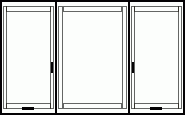You are here
Types of Windows
Each window is made up of eight elements:
 (1) The Head is the part of the window which lies across the top of the frame.
(1) The Head is the part of the window which lies across the top of the frame.
(2) A window's Jamb refers to the multiple vertical segments that make up the sides of the frame itself.
(3) The entire area where the window sash and door panels are located is called the Frame.
(4) Glazing can refer either to a window's glass or the process of putting glass into the window.
(5) A Pane is simply an individual unit of glass.
(6) The frame that holds the panes of glass, when assembled as a unit is referred to as the Sash.
(7) The Sill is the bottom part of the frame underneath the window.
(8) The Muntin Bar is a bar that divides window glass.
Here are the most common operating styles and configurations:

Awning Windows
These windows consist of a sash hinged to the top jamb or the sill, and tilt out when opened using hardware similar to casement windows.

Bay Windows
These windows consist of one or more center sashes framed to bump out or protrude beyond a wall with angled or perpendicular side sashes running back to the wall.

Bow Windows
These windows are similar to bay windows, but the windows are framed to form a gradual arc instead of the sharp angles of a bay.

Casement Windows
These windows usually consist of one sash hinged to a side jamb and open outward from the sill by using a crank handle or slider bar.

Double-Hung Windows
These windows consist of two sashes that slide vertically along side jambs with the bottom sash closing down on the sill and the top sash closing up against the top jamb.Â

Slide-By Windows
These windows function like double-hung windows turned sideways.
Transom Windows
These windows usually consist of short awning windows or fixed sashes mounted over normal sized casement or double-hung windows.
